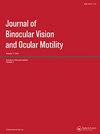Localizing Rectus Muscle Insertions
Q3 Medicine
Journal of Binocular Vision and Ocular Motility
Pub Date : 2022-09-06
DOI:10.1080/2576117X.2022.2114309
引用次数: 0
Abstract
To the editor, We congratulate Mirmohammadsadeghi et al. for their study on the use of ultrasound biomicroscopy (UBM) and the Anterior Segment Optical Coherence Tomography (ASOCT) in a cohort of patients undergoing strabismus surgery. However, this is not the first study comparing the UBM and ASOCT in locating muscle insertions. We have recently reported the feasibility and accuracy of determining the extraocular muscle insertion distance from the limbus in previously operated extraocular muscles with the swept-source ASOCT and compared with wide-field UBM. The technique and expertise when using both the instruments must be stressed. In the present study, two operators were doing the two measurements; hence, additional masked interpreters of both images could have strengthened the study. Intraclass correlations could be obtained to make sure one operator was not better than the other or the ease of identifying the muscle insertion could be compared with the same operator doing both measurements. Eye position and degree of head rotation might influence the measurements, and maximum rotation might provide the best delineation. Hence, the degree of rotation can also be standardized. The authors have not mentioned what gel they used as a coupling medium. The clear scan (Clear Scan (ClearScan® Ultrasound Cover CS200, ESI Inc, USA)) or any other sterile disposable cover, is the most comfortable to use without the cup and can image increasing distances, in our experience (No financial interest). The intraoperative caliper measures precisely up to 1 mm, so an estimation of 0.5 mm on the caliper, can be a limitation. The farthest distance measured by the machines is 8.5 and 9.3 mm. We would like to know whether this measurement was of primary or re-operated muscles as the measures are much less than that reported in the literature. The authors mention that five measures on ASOCT were within 1–1.5 mm. This number is very high, so what do the authors speculate about the reason for this variability? Could the authors tell us which muscle (MR/LR) is being referred to when comparing measurements between esotropia and exotropia. We presume the figure shown by the author was that of primary surgery; and we would like to know how did the operators find the delineation of insertions in reoperations? It is important to note that the utility of these instruments is diminutive in cases of primary strabismus surgeries. Hence, more qualitative and quantitative information is required about the measurements in reoperations. The three cases of reoperations reported by the authors do add to the limited literature in this area. We achieved an accuracy of 69% of imaging insertions within 1 mm vs. 38% by the UBM in cases of reoperations. We need more studies in a more significant number of reoperations to expand the utility of the ASOCT. The current evidence indicates that the ASOCT identifies the muscle insertion distance more accurately than UBM, more so in reoperations besides being noncontact and having high patient comfort. The paper by Mirmohammadsadeghi et al. is a valuable addition to the research in this area.定位直肌插入部位
我们祝贺Mirmohammadsadeghi等人在斜视手术患者队列中使用超声生物显微镜(UBM)和前段光学相干断层扫描(ASOCT)的研究。然而,这并不是第一个比较UBM和ASOCT定位肌肉插入的研究。我们最近报道了用扫描源ASOCT测定以前手术过的眼外肌离角膜缘的止点距离的可行性和准确性,并与宽视场UBM进行了比较。必须强调使用这两种工具时的技术和专业知识。在本研究中,两名操作员分别进行两项测量;因此,对这两幅图像进行额外的蒙面解释可能会加强这项研究。可以获得类内相关性,以确保一个操作员不比另一个操作员好,或者可以比较同一操作员进行两种测量时识别肌肉插入的难易程度。眼睛的位置和头的旋转程度可能会影响测量,最大的旋转可能会提供最好的描绘。因此,旋转的程度也可以标准化。作者没有提到他们使用了什么凝胶作为耦合介质。根据我们的经验(无经济利益),透明扫描(ClearScan®超声盖CS200, ESI Inc,美国)或任何其他无菌一次性盖,在没有杯子的情况下使用最舒适,并且可以显示越来越远的图像。术中卡尺精确测量到1mm,因此卡尺上0.5 mm的估计可能是一个限制。机器测得的最远距离为8.5和9.3毫米。我们想知道这个测量是主要的还是再手术的肌肉,因为测量结果比文献中报道的要少得多。作者提到ASOCT的5个测量值在1-1.5 mm范围内。这个数字非常高,那么作者对这种差异的原因有什么推测呢?作者能否告诉我们,在比较内斜视和外斜视的测量结果时,所指的是哪一块肌肉(MR/LR) ?我们假定作者所示的数字是初级手术的数字;我们想知道操作员是如何在再操作中找到插入的描述的?值得注意的是,在原发性斜视手术中,这些器械的效用很小。因此,需要更多关于再操作测量的定性和定量信息。作者报告的三例再手术确实增加了该领域有限的文献。我们在1mm内实现了69%的成像插入准确率,而在再次手术的情况下,UBM的准确率为38%。我们需要对更多的再手术进行更多的研究,以扩大ASOCT的应用范围。目前的证据表明ASOCT比UBM更准确地识别肌肉插入距离,在再手术中更准确,而且非接触性和患者舒适度高。Mirmohammadsadeghi等人的论文对这一领域的研究是一个有价值的补充。
本文章由计算机程序翻译,如有差异,请以英文原文为准。
求助全文
约1分钟内获得全文
求助全文
来源期刊

Journal of Binocular Vision and Ocular Motility
Medicine-Ophthalmology
CiteScore
1.20
自引率
0.00%
发文量
42
 求助内容:
求助内容: 应助结果提醒方式:
应助结果提醒方式:


